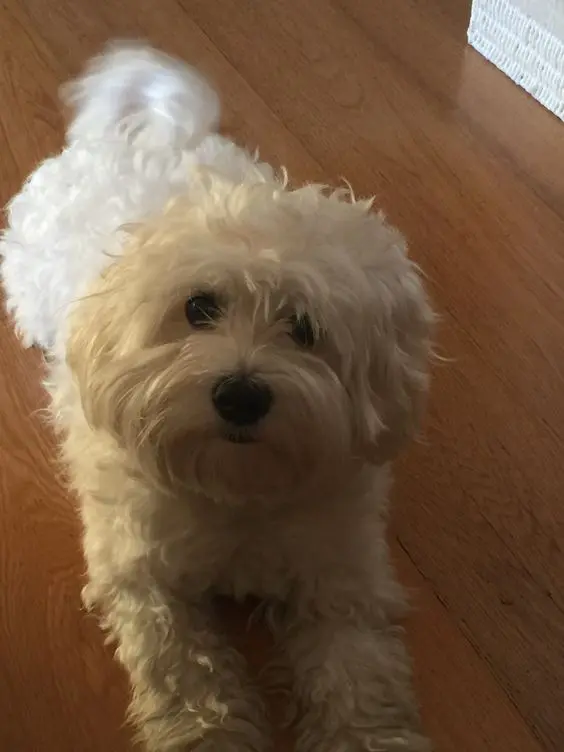When it comes to our beloved Maltipoos, their well-being is always a top priority.
Helping them maintain a good quality of life means being informed about every part of their health, even the less glamorous areas.
One such important but often overlooked aspect is the health of their anal glands. While not a particularly pleasant topic of discussion, it’s critical for pet owners to recognize and address any issues that might arise.
Here we’ll explore five crucial points to ensure you’re well-prepared to care for your Maltipoo’s anal glands.

1. Understanding Maltipoo Anal Glands
Maltipoo anal glands, also known as scent glands, are located just inside the rectum.
They play a crucial role in dog communication and territory marking, secreting a unique olfactory message when a dog passes feces.
In the wild, this scent can help to communicate a dog’s presence and status to others. Domesticated dogs, however, may not need these glands as frequently or as potently.
Despite this, the glands continue to secrete and should be expressed regularly to prevent buildup and potential problems.
2. Signs of Anal Gland Issues
Anal gland problems are more common than one might think. Visible signs such as excessive licking, scooting the rear end along the ground, swelling, or a foul odor could indicate a problem with the anal glands.
The scent may be particularly pungent if the glands are impacted or infected.
Keep an eye on your Maltipoo’s behavior—signs of discomfort or unusual rear-end activity could be a signal that the anal glands need attention.
3. Home Care Tips
Maintaining healthy anal glands at home can be a simple yet important part of your dog’s grooming routine. Some measures you can take include:
1. Proper Grooming
Regular grooming is vital for your pet’s well-being, particularly when it comes to the anal region. By maintaining proper hygiene in this area, you can prevent the glands from becoming blocked, which could lead to discomfort and potential health issues.
Trimming the area not only keeps it clean but also reduces the likelihood of fecal matter or hair causing blockages in the gland’s ducts, ensuring your pet’s comfort and overall health.
2. Diet
The right diet can play a role in the health of your dog’s anal glands. A high-fiber diet can help keep your Maltipoo’s bowel movements firm, which assists in the natural expression of the glands’ secretions during defecation.
3. Regular Exercise
Making sure your Maltipoo receives sufficient exercise not only benefits their physical health but also plays a role in promoting healthy bowel function and ensuring regular expression of the anal glands, which are important aspects of your furry friend’s overall well-being.
It’s crucial to incorporate physical activity into your Maltipoo’s routine to support their digestive health and prevent any potential issues related to their anal glands.

4. When to Seek Veterinary Help
Sometimes, home care isn’t enough, and professional help is required. If you notice any of the following, it’s time to schedule a visit to the vet:
1. Persistent Symptoms
If your Maltipoo continues to exhibit signs of anal gland discomfort, such as scooting or licking the area excessively, even after attempting home care like dietary adjustments or warm compresses, it could indicate a more serious issue that requires veterinary attention.
It’s essential to seek help from professionals to ensure your furry friend’s well-being and address any underlying concerns promptly.
2. Visible or Pus-Like Discharge
This suggests a bacterial infection, and it will require treatment with antibiotics. Your veterinarian can provide a prescription for the appropriate medication to help address this issue effectively.
3. Sensitivity or Redness
If the area around the gland becomes inflamed or painful, your vet can assist in providing relief and treating the underlying cause.
5. Prevention Strategies
Prevention is always better than cure. Some simple strategies can help you prevent anal gland issues in your Maltipoo:
1. Regular Check-ups
Ensure to have your veterinarian inspect your Maltipoo’s anal glands as part of their routine check-ups.
Detecting any potential issues early on is crucial as it can help prevent the development of more severe problems in the future.
Regular monitoring of your pet’s anal glands is a proactive step towards maintaining their health and well-being.
2. Consistent Grooming
Maintain a consistent grooming schedule, and pay attention to your Maltipoo’s rear end. If you’re not comfortable grooming your dog yourself, seek professional grooming services.
3. Good Diet
Ensure your dog is on a nutritious, balanced diet. Talk to your vet about the best dietary options to support healthy gland function.
4. Keep Hydrated
Make sure your Maltipoo has access to plenty of water, as adequate hydration can help prevent constipation, which can contribute to anal gland problems.
Conclusion
Maltipoo anal gland health may not be the most pleasant topic, but it’s undeniably important.
Regular grooming, a healthy diet, and being vigilant about your dog’s behavior can go a long way in preventing anal gland issues.
If problems do arise, don’t hesitate to consult with your vet. By staying informed and proactive, you can help ensure your Maltipoo lives a comfortable, happy, and odor-free life.








